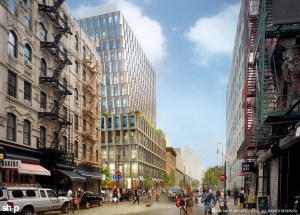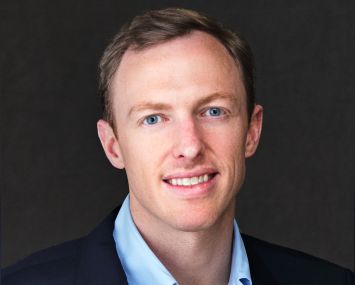Home Ron: L+M CEO Ron Moelis is Having His Moment

Ron Moelis was having a busy morning.
He was scheduled to be in Brooklyn for the groundbreaking at Greenpoint Landing—a half-mile, 22-acre project along the waterfront—where Mr. Moelis’ company, L+M Development Partners, is constructing 294 affordable apartments. There was the usual litany of last-minute cancellations for speakers, and Ubers that never materialized.
But Mr. Moelis, chief executive officer and founding partner of L+M, still managed to slip away from his Park Avenue South office and meet Commercial Observer for breakfast at Asellina at the Gansevoort Park Avenue Hotel with his daughter, Kate (an undergrad at the University of Pennsylvania), in tow. He ordered a fruit plate—his daughter bacon and eggs (a few strips somehow migrated to Mr. Moelis’ plate).
It shouldn’t come as a surprise that Mr. Moelis is a good juggler; few developers have as much in the pipeline as he. Aside from Greenpoint Landing, he’s also at work on about 630,000 square feet at the Marcus Garvey projects in Brownsville (625 affordable apartments) and—the pièce de résistance for any developer—Essex Crossing, the 1.9 million-square-foot residential and commercial behemoth on the Lower East Side that L+M is doing with Taconic Investment Partners and BFC Partners.
There’s a lot more L+M is working on. But at a certain point, he had to get to Greenpoint…
Commercial Observer: It seems like affordable housing is having its moment.
Mr. Moelis: It’s a big part of [Mayor de Blasio’s] agenda, obviously; the Bloomberg administration did a lot on affordable housing as well—the city’s been pretty prolific as to how much affordable housing they produce relative to the rest of the country. But it’s become a much bigger part of the political agenda with de Blasio. His goals are grander. I think the big moments are going to be surrounding developments that are in the boroughs mostly, or northern Manhattan—more community-driven economic development. Whereas with the Bloomberg administration, the big projects, whether it’s Hudson Yards or Willets Point, or even Atlantic Yards, were driven by the market and more economic development.
How did you get into affordable housing originally?
Well, I went to Wharton Business School and NYU Law School; I practiced law for four or five months, and quit…
Four or five months? That’s it?
I wasn’t really made for law. A classmate of mine was dating a guy who was in his family construction business and he also left. And we started a partnership; we started doing work in the East Village—[we did] a rehab on Avenue B and 7th Street in 1985 or 86—and it came with a deed restriction. The building had been purchased by Harry Chapin—I don’t know if you remember [the songwriter] Harry Chapin?

Yeah…
So Harry Chapin died in the car crash on the [Long Island Expressway]. He and his brother were trying to buy the building from the city and when he died, the Board of Estimates decided to sell it to his brother, but they put a deed restriction, which called for 25 percent affordable housing. We bought the buildings from his brother. We get to the closing, and the title company says to us, “We’re not going to insure against title unless you go to the city and get proof that you’re going to build this 25 percent affordable housing.”
So we hired someone who went to the general council at [Housing Preservation and Development]—we didn’t even know what HPD was at the time, and we spent about three or four months working with them. And that was our first contact with HPD and the city’s housing plan.
This was in ’88 and I found that I liked it; it was aligned with my interests and political beliefs. This was also around the time when Reagan passed the 86 Tax Act, so the whole Federal focus changed from HUD-driven, federally subsidized, Mitchell-Lama-type buildings, to tax credit-driven projects. I was really the first one in New York City to figure out how to integrate—because it was new—with the mayor’s housing plan at the time. We were kids starting out, so we didn’t have any money; we weren’t competing with the Rudins and the Litwins of the world, and you didn’t need a ton of money to get started.
I do want to know the story of the four to five months that made you give up on the law.
Actually, I clerked for a judge for a year, and as a law clerk you have a lot of authority—you’re writing decisions, drafting decisions, I was dealing with senior lawyers—then you go to a law firm and you’re like the bottom of the barrel, doing closing memos. I think the reason I went to law school was [that] at 12, I probably watched Perry Mason or something and thought I was going to be a trial lawyer, and that wasn’t happening.
People were saying, “Stay for a couple years, get the experience, then leave.” And I thought, if I don’t want to be a lawyer, what kind of experience am I getting? My brother and myself and a friend had been investing in apartments—like buying insider apartments when buildings were going co-op in the early ’80s and fixing them up, modestly painting them, doing floors, then selling them, making a few dollars and it was fun. Realistically, it seemed like an interesting area.
Affordable housing strikes me as really hard to do because construction costs are so high and land prices are insanely high. How does that work now?

Well, it’s a challenge. The mayor’s put more resources into it, and they’ve also sharpened their pencils—maybe at times too sharp. They’ve got a team that’s pretty experienced in this area, the Deputy Mayor [Alicia Glen] was doing this for 15 years. The Housing Commissioner [Vicki Been] has been in this business a long time. The head of HDC [Gary Rodney] was a developer in the business, so they know the math. Costs have gone up, and that’s a challenge, in particular the construction costs. Long term, I think the land is going to be a huge challenge. In the short term there is a pipeline of activity that both the city and some developers, including us, have that are allowing us to close and develop projects at lower land costs than would work under the current market. We’re not relying on buying land in the market right now. And if you had to go out and buy land in the market right now, you wouldn’t be able to make the numbers work under the current program and current land costs. We have a pipeline of a few million square feet of land at virtually no cost that will all go to affordable and mixed-income housing. And as we saw [last month], the 421-a legislation, which the mayor proposed, could double the amount of affordable housing that has to go through a labor negotiation. So we don’t know where that’s headed, but that all impacts us.
Tell me a little bit about Essex Crossing. I think you guys broke ground this spring, is that right?
I think it’s a miracle that we broke ground so quickly. We got designated a year and a half ago, and it’s approximately 2 million feet, about half of that is housing, [and] about half the housing’s affordable. The other half is commercial—community facilities, retail, a museum. We’re recreating the state-of-the-art Essex Street Market. Bigger and better—we hope.
After doing this for 30 years, affordable housing is fairly easy. There’s a lot there for affordable housing, there’s a lot of discussion, a lot of money incentives, capital. What’s really difficult is building the neighborhoods and the ancillary aspects of it: the retail, the security, the education, the food, the infrastructure, the transportation. So when we build in the South Bronx, or central Brooklyn or the Rockaways, and there’s no place for the people who live in the housing to go buy quality food, or the school system is not that good, or there’s no community programming, there’s no open space. So all that ancillary infrastructure that surrounds the housing, that’s what we’re really focused on now. I think this mayor is also focusing on that, much more so than past administrations.
I’ll admit that in some of the things we built, we didn’t think about what we were doing on the ground floors or in the open-space areas; we sort of said, “Oh, we’ll deal with that later.” Then you put in whatever came along. You try not to put a McDonald’s in, but if you have a dollar store, maybe you put it in, because you have to make the economics work. Essex Crossing is a great example, where you’re getting a mix of housing, a rebuilt Essex Street Market, you’re getting the food, getting family entertainment, a school (which we’re not building but it’s reserved for the site), improvements to the transportation system. It was just a very thoughtful plan—that took 48 years, granted, but I think they got it right. You can’t necessarily take that kind of land in Brownsville and do the same thing. But we do have a million feet in Brownsville, we’re trying to do the same thing on a scale that works.
What’s the story in Brownsville?
It’s a 625-unit Mitchell Lama that was pretty much falling apart. We’re doing a major overhaul, recapitalization and renovation; we’re in the midst of that now. It’s about a [$189 million] development and it has seven unused parking lots, and those parking lots are zoned for a fairly significant development. We’re working with urban farmers and they’re starting, I think in [a couple of weeks], a farmers’ market. And we’re going to do an urban garden and eventually put one on the roof of one our buildings. The idea is really to take the mayor’s vision of an Essex Crossing concept in an inner-city environment. We may not get Fairway to come in, but maybe we’ll get a healthy foods store, local food. We’re doing a whole job push there for youth. There’s a lot of public housing there. We have a training program for construction work called “Building Skills,” that I’m the chair of and that we started a few years ago, to train youth and people who are in areas of underemployment.
What’s your timeline?
It’s probably a good year to two until we break ground on the first group of those buildings. My guess is it will be [finished] in seven to 10 years.
If we can go back to Essex Crossing for one moment. You said it was in the process for 48 years?
You mean the Seward Park redevelopment? [Essex Crossing’s first incarnation.] In the ’60s, it was declared an urban-renewal area, the whole area was razed. They relocated a lot of the people living there because they were going to redevelop it. And as you know, the Lower East Side is a fairly unique area with a lot of constituencies both ethnic and otherwise, and nobody could agree on what to do. There’s a big Asian community, there’s a big Hispanic community, there’s a big Jewish community, and there’s a lot of nonprofits, a lot of settlement houses, a lot of history. They had obviously a very influential assemblyman. I’m not sure if he’s still influential…
You’re talking about Shelly Silver, of course.
In the last seven years the city took a real interest in wanting to make this work. They went out with a [Request For Proposal]. We spent $1 million [on our proposal]—there were at least 10 respondents, in fact we were probably a long shot at the time, I mean you had Forest City, Related, Vornado—a lot of big developers. The city ended up bringing the top proposals in front of the community group. They didn’t discuss names—so the community planning group didn’t know it was L+M or Related. A lot of these guys have done mixed-use, housing, retail and commercial, but not many had done real mixed-income. We were probably one of the few who could do the scale of this job and we had a partner who knew the commercial side.
It’s the most visible project we’ve done. It’s also an enormous commitment of capital. In phase one alone we have $150 million of equity and $415 million in debt in the project. There’s going to be a lot of political visibility on how we do it. And there will be a lot of criticism as well as accolades. To me what’s most important is how these uses are integrated and how it’s perceived by the people who live there. I’m sure there are people there who will say, “It should have all been affordable housing,” and I’m sure there are people who’ll say, “You should have brought more entertainment in,” but I think the goal at the end is to have the vast majority of voices say, “You really integrated this well. You didn’t just bring in $50 million apartments.”
It’s funny that you’re working on Essex Crossing on the Lower East Side—it’s almost a return to your roots.
Right, it’s true. (Laughs.) It is a return to a different place than where I started, but yes. Both my grandfather and grandmother from different sides of my family grew up on the Lower East Side. My grandfather, who was around during the early part of my career, and when I started working on 7th Street and Avenue B—he said he grew up on 5th Street around A and B—and he was like, all he wanted to do was get out of the neighborhood and I’m building condos at the corner!


